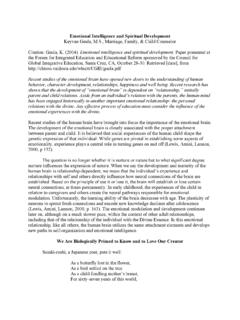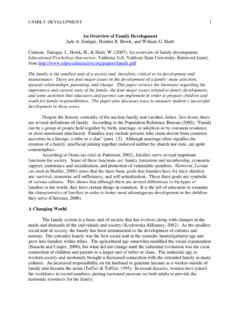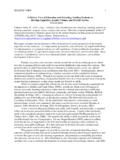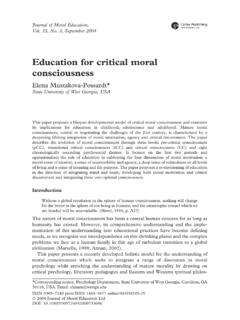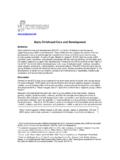Transcription of Social Development: Why It Is Important and How …
1 Running head: Social development 1 Social development : Why It Is Important and How To Impact It William G. Huitt Courtney Dawson Citation: Huitt, W. & Dawson, C. (2011, April). Social development : Why it is Important and how to impact it. Educational Psychology Interactive. Valdosta, GA: Valdosta State University. Retrieved from Human beings are inherently Social . Developing competencies in this domain enhance a person s ability to succeed in school as well as positively influence mental health, success in work, and the ability to be a citizen in a democracy. This paper outlines research and theories related to the development of Social competence and provides a literature review of theory and research supporting the vital importance of Social competence, including a discussion of empirically-based interventions and measurement tools that educators can use to facilitate development of Social competence.
2 When Aronson (2003) first published The Social Animal in 1972, he confirmed scientifically what people knew experientially: Human beings are Social in their very nature. In fact, Dunbar (1998) hypothesized that the large human brain evolved primarily to adapt to an increasingly complex Social environment. As Goleman (2006) puts it: [W]e are wired to connect. The domain of Social intelligence and development is a critical component of descriptions of human ability and behavior (Albrecht, 2006; Gardner, 1983/1993, 2006). Social skills are Important for preparing young people to mature and succeed in their adult roles within the family, workplace, and community (Ten Dam & Volman, 2007). Elias et al. (1997) suggested those involved in guiding children and youth should pay special attention to this domain: Social skills allow people to succeed not only in their Social lives, but also in their academic, personal, and future professional activities.
3 For educators, it is increasingly obvious that learning is ultimately a Social process (Bandura, 1986; Dewey, 1916; Vygotsky, 1978). While people may initially learn something independently, eventually that learning will be modified in interaction with others. Defining Social Intelligence As with other domains, there are inconsistences within and between the definitions of Social intelligence (a capacity or potential) and Social competence (an achievement or actualization of potential). For example, Gardner (1983/1993) defined Social intelligence (labeled interpersonal intelligence) as the ability to notice and make distinctions among other individuals and, in particular, among their moods, temperaments, motivations, and intentions (p. 239). Goleman (2006) defined Social intelligence as being intelligent not just about our relationships but also in them [p. 11, emphasis in original].
4 His definition includes both the capacity to be socially aware (with components of primal empathy, attunement, empathetic accuracy, and Social cognition) as well as the ability to develop Social skill or facility (including components of synchrony, self-preservation, influence, and concern). The latter is Albrecht s (2006) primary focus he defined Social intelligence simply as the ability to get along well with others and to get them to cooperate with you (p. 3). In our opinion, Albrecht s definition is Social development 2 closer to defining Social competence rather than Social intelligence. A definition of intelligence should focus on the ability to learn to do something rather than being competent at it. In each of these definitions, cognitive/thinking, affective/emotional, and conative/volitional components are considered Important because they provide the foundation for the establishment and maintenance of interpersonal relationships.
5 Therefore, any attempt to develop Social capacity ( , intelligence) into Social competence will need to consider these other domains as well. There is some controversy about whether Social intelligence really exists in a manner similar to cognitive intelligence and the extent to which it can be developed through learning experiences (Weare, 2010). There are similar controversies when discussing other domains such as emotion (Brett, Smith, Price, & Huitt, 2003) and conation (Huitt & Cain, 2005). However, there is no debate about whether people vary in their ability to learn and develop Social skills. Defining Social Competence Bierman (2004) defined Social competence as the capacity to coordinate adaptive responses flexibly to various interpersonal demands, and to organize Social behavior in different Social contexts in a manner beneficial to oneself and consistent with Social conventions and morals (p.)
6 141). Broderick and Blewitt (2010) identified four categories of foundational Social competencies: (1) affective processes (including empathy, valuing relationships, and sense of belonging), (2) cognitive processes (including cognitive ability, perspective taking, and making moral judgments), (3) Social skills (including making eye contact, using appropriate language, and asking appropriate questions), and (4) high Social self-concept. The Collaborative for Academic, Social , and Emotional Learning (CASEL, 2003, 2007), one of the leaders in the development of Social -emotional learning (SEL), identified five teachable competencies that they believe provide a foundation for effective personal development : 1. Self-awareness: knowing what one is feeling and thinking; having a realistic assessment of one s own abilities and a well-grounded sense of self-confidence; 2. Social awareness: understanding what others are feeling and thinking; appreciating and interacting positively with diverse groups; 3.
7 Self-management: handling one s emotions so they facilitate rather than interfere with task achievement; setting and accomplishing goals; persevering in the face of setbacks and frustrations; 4. Relationship skills: establishing and maintaining healthy and rewarding relationships based on clear communication, cooperation, resistance to inappropriate Social pressure, negotiating solutions to conflict, and seeking help when needed; and 5. Responsible decision making: making choices based on an accurate consideration of all relevant factors and the likely consequences of alternative courses of action, respecting others, and taking responsibility for one's decisions. Based on extensive research over the past two decades, many investigators proposed that school curricula must provide learning experiences that address students development in the cognitive/academic, emotional, Social , and moral domains (Cohen, 2006; Elias, & Arnold, 2006; Narvaez, 2006), Zins, Weissberg, Wang, & Walberg, 2004).
8 As with the definitions of Social intelligence, the different components of Social competence provided by Broderick and Blewitt (2010) and CASEL (2003, 2007) involve the Social development 3 domains of cognition/thinking (perspective taking, making moral judgments, responsible decision making), affect/emotion (empathy, valuing relationships, self-awareness, and handling one s emotions), and conation/self-regulation (self-management setting and accomplishing goals; persevering), in addition to the Social domain ( Social awareness, relationship skills such as making eye contact and using appropriate language). Broderick and Blewitt s inclusion of Social self-views provides an insight into the complexity of addressing Social competence. Therefore, an effective Social development program will include elements of developing the foundational competencies in other domains that support and enrich it and will do so in a way that the child or adolescent has high Social self-esteem in a variety of Social situations.
9 Based on the discussion above, a comprehensive definition of Social competence would include a person s knowledge, attitudes, and skills related to at least six components: (1) being aware of one s own and others emotions, (2) managing impulses and behaving appropriately, (3) communicating effectively, (4) forming healthy and meaningful relationships, (5) working well with others, and (6) resolving conflict. The remainder of this paper outlines research and theories related to the development of Social competence and how it is directly related to education and schooling. The next section offers a literature review of theory and research supporting the vital importance of Social competence to academic achievement as well as successful adulthood. The final two sections provide a discussion of empirically-based interventions and measurement tools as well as additional resources for teachers and administrators.
10 Understanding Social development This section is organized around two different perspectives on understanding Social development : theories and research. Theories Related to Social development According to Bowlby (1969/1982, 1988), an infant s attachment to a caregiver serves as the foundation for all future Social development . He suggested that attachment is biologically-based and is intended to ensure that infants and children have enough support and protection to survive until they are able to function independently (Gilovich, Keltner & Nisbett, 2006). Ainsworth, Blehar, Waters, & Wall (2015) found four distinct categories of attachment: securely attached (about 65%), avoidant-insecurely attached (about 20%), anxious-ambivalently attached (about 10%), and about 5% whose attachment was categorized as disorganized-disoriented. According to Ainsworth et al., the attachment patterns developed in infancy and toddlerhood are fairly stable throughout the lifespan.
